Let me introduce you to Mel. He's a little stuffed koala that my wife and I take on our travels, and as it turns out we much prefer to take pictures of where Mel has been been than where we've been.
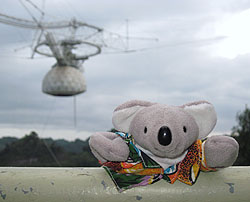
J. Kelly Beatty
Last week Mel found himself in Puerto Rico, where I was covering the 41st annual meeting of the American Astronomical Society's Division for Planetary Sciences. After the meeting concluded, we headed west from San Juan to visit Arecibo Observatory.
I'd been to Arecibo before, but on this particular visit I was keen to see the big dish in action. Luckily, that evening astronomer Marina Brozović (Jet Propulsion Laboratory) planned to "ping" a small near-Earth asteroid designated 1999 AP10 to try to determine its shape and surface characteristics.
These are challenging times for the observatory. In 2006, a top-level review for the National Science Foundation concluded that the facility should either find funding from non-NSF sources or be closed. Even though an National Research Council report released last month affirms that the observatory provides "unmatched precision and accuracy" in detecting asteroids or comets that could hit the Earth, as things stand now there'll be no more money to fund Arecibo's unique radar capability after fiscal year 2010. You can get more background via the Arecibo Science Advocacy Partnership (ASAP).
I'll have more to say about Arecibo's precarious future at a later date, but for now let's get back to Mel's excellent adventure. As the photos below attest, the observatory is an amazing place. In a few years it may no longer be the world's largest radio dish, but for now there's no place like it on Earth.
Mel thanks staffers Mike Nolan and Ellen Howell, who paved the way for his visit and also served as gracious hosts.
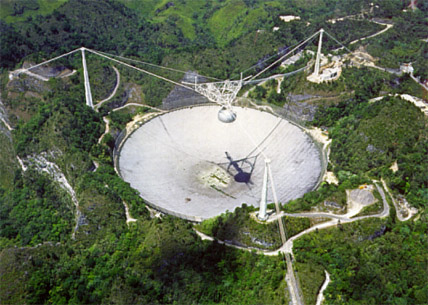
Built in the early 1960s in part to study how radio waves propagate through Earth's upper atmosphere, the Arecibo dish takes advantage of a huge natural depression in the limestone deposits of western Puerto Rico. It's 1,000 feet (305 meters) across — to appreciate fully how big that is, you need a bird's-eye view like this one (or something higher up). The dish itself is spherical in shape, so only a portion can be used at any given moment to bring radio waves to focus.
Tony Acevedo / Arecibo Obs. / NAIC
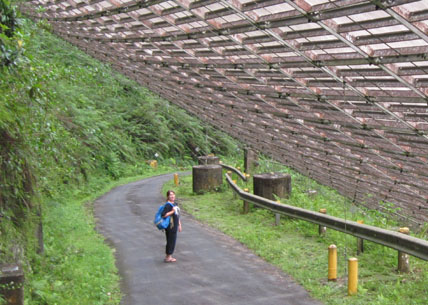
The dish's original surface was just wire mesh. But in 1974 that was replaced by 38,778 perforated aluminum panels, each measuring about 6 by 3 feet, suspended above the ground by a system of cables and tie-downs. The radio wavelengths of interest to astronomers are much longer than the perforations within the aluminum panels, so the dish appears "solid" to incoming radiation.
J. Kelly Beatty
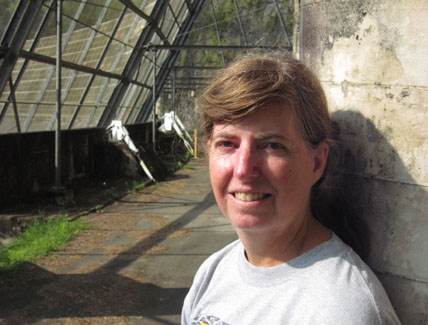
Research associate Ellen Howell fell in love with Caribbean life and has been at Arecibo for 9 years. She helps visiting astronomers get the most from their runs, and when time permits she studies the surface compositions of asteroids by observing their visible and near-infrared spectra.
J. Kelly Beatty
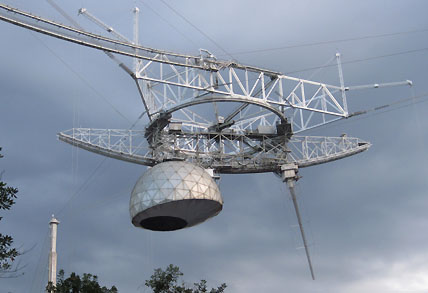
Suspended 500 feet (150 m) up is this massive antenna platform, which weighs 900 tons. The 96-foot-long pole at right is a receiver for S-band signals (430 megahertz). The big round structure, added in 1997, houses a Gregorian system with two curved reflectors that bring the incoming radiation to a single focus. Everything moves back and forth along the curved 300-foot-long azimuth arm, which can rotate 360° while tracking objects across the sky. Access to the platform is via catwalk (at upper left) or a four-person cable car. One of three support towers is at lower left.
J. Kelly Beatty
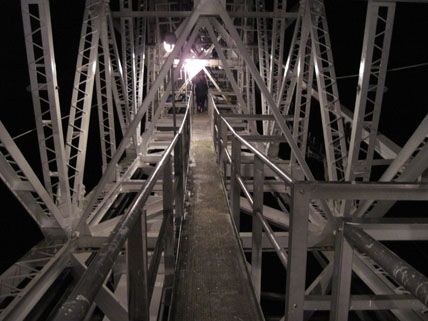
Mel (along with his handlers) got a behind-the-scenes tour at night. It's probably just as well that we couldn't look out through the gridwork to see the dish hundreds of feet below us. Here we're walking along the curved azimuth arm. The footing was incredibly solid — suspension cables from the three support towers keep the height of the antenna platform constant to within 1 mm!
J. Kelly Beatty
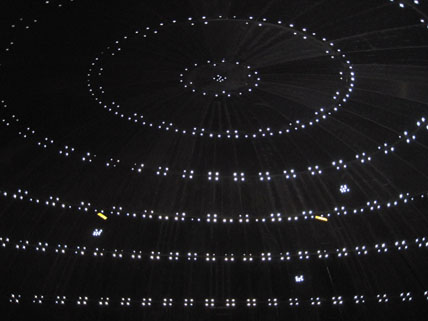
Our tour took us down into the housing for the Gregorian reflector, a feeling something like being inside an alien spaceship. This strange flash-aided photo reveals the pattern of reflective targets that are used to maintain alignment of the outer reflector.
J. Kelly Beatty
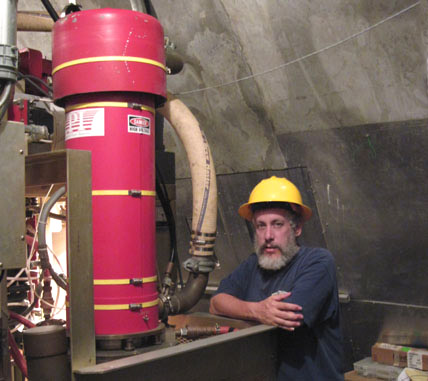
Mike Nolan, who directs the observatory and its radar-astronomy operations, stands next to one of Arecibo's two klystrons. Together they can continuously pump out 1,000,000 watts of S-band radio energy for radar work. A beam of such power would be lethal, so before every radar run two staffers walk through the entire antenna platform to make sure no one is accidentally left up there. (Amazingly, one of the platform's emergency safe zones is inside this room!)
J. Kelly Beatty
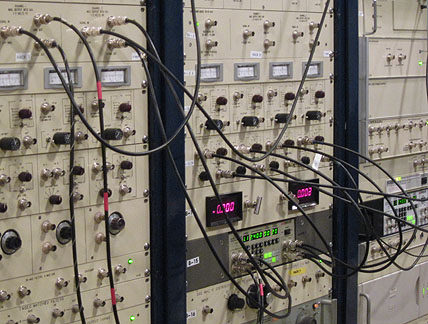
Equipment racks in the observatory's control room can be wired in myriad (confusing) ways to direct the incoming radio signals.
J. Kelly Beatty
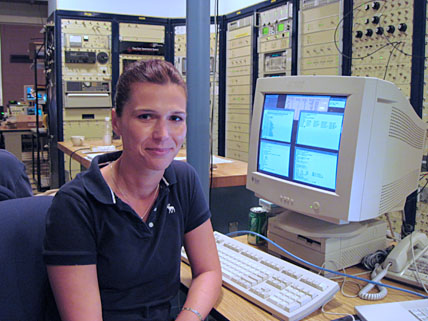
Marina Brozović settles in for the night's observing run, involving near-Earth asteroid 1999 AP10. She'll follow this asteroid and a second, 2001 CV26, for the next week. In the past 2½ years she's hunted down about two dozen objects like these using Arecibo and NASA's big tracking dish at Goldstone, California. Click here for a 2-minute video recap of the first night's observations.
J. Kelly Beatty
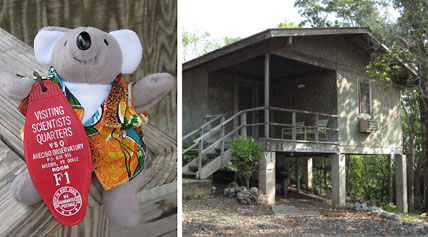
Mel has awakened refreshed and ready to go after a hard night's observing. (If you're a fan of the movie Contact, the little bungalow at right will remind you of the one shared by actors Jodie Foster and Matthew McConaughey.)
J. Kelly Beatty
 11
11
Comments
Naomi
October 15, 2009 at 11:27 am
So great to see the people and the environment of such an iconic piece of wonder in astronomical science. I am a huge fan of "Contact" and really enjoyed seeing inside what we only get a glimpse of in the movie. Looks like there are still a few Ellen Arroways left working there, but are any of them listening for an intelligent message from beyond? Perhaps we are beyond listening, as they may already be here making contact in person.
You must be logged in to post a comment.
Bud
October 16, 2009 at 2:25 pm
I grew up in Puerto Rico. I saw the amazing sight of a structure apparently brought here from the 24th century when it was brand new. Thomas Gold. Cornell University. This was big, impressive news.
Now I hear it may be closed in a few months. How sad! This magnificent window into the universe that we're just beginning to understand will be closed before we even get to the 24th century.
Is there anything a fan out here on the west coast of the US can do to help avert the closing? Before it gets converted to a skateboard park?
You must be logged in to post a comment.
Bud
October 16, 2009 at 2:25 pm
I grew up in Puerto Rico. I saw the amazing sight of a structure apparently brought here from the 24th century when it was brand new. Thomas Gold. Cornell University. This was big, impressive news.
Now I hear it may be closed in a few months. How sad! This magnificent window into the universe that we're just beginning to understand will be closed before we even get to the 24th century.
Is there anything a fan out here on the west coast of the US can do to help avert the closing? Before it gets converted to a skateboard park?
You must be logged in to post a comment.
pete from north central Mass
October 16, 2009 at 5:24 pm
Thought I recognized this dish (not Ms. Brozovic, although she's a dish also). Just finished watching "Contact" the other night. Never realized how truly awesome this massive dish is. And like in the movie, money is always the bottom line, sadly. "No bucks, not Buck Rogers", as the saying went in the movie "The Right Stuff". But this dish has all the right stuff, just needs a better selling job to the public, I guess.
You must be logged in to post a comment.
Nathaniel Sailor
October 16, 2009 at 7:01 pm
It wpuld be a bad idea to close the telescope. But if the money runs out, they will have no choose but to close it. I hope the obsevitory can get the funds.
You must be logged in to post a comment.
Nathaniel Sailor
October 16, 2009 at 7:01 pm
It wpuld be a bad idea to close the telescope. But if the money runs out, they will have no choose but to close it. I hope the obsevitory can get the funds.
You must be logged in to post a comment.
Dave
October 18, 2009 at 2:52 am
Let's not dwell on the closing......let's figure out how to save this treasure, starting NOW. My observtions conclude, as others have, that Ms Brozovic is indeed a considerable dish, but on a different "curve" plane.
You must be logged in to post a comment.
Tom
October 18, 2009 at 9:16 am
As of this moment, 2 of 7 comments are about the appearance of one of the female researchers. No wonder women are put off getting into science.
You must be logged in to post a comment.
Alison
October 18, 2009 at 6:09 pm
Interesting photos -- "alien spaceship" & aerial shots are very cool.
Maybe Mel's adventures in astronomy should be a regular feature? 🙂
You must be logged in to post a comment.
Bill Besselievre
October 20, 2009 at 1:28 pm
My first engineering job after graduating from Bucknell U. (1963) was for Praeger-Kavanagh (the consultant for the telescope's design & construction) in Arecibo. A wonderful experience! Using precision instruments, we meticulously established exacting locations for dish tiedowns & the superstructure. The construction tolerances were miniscule vis-a-vis conventional engineering projects. The work was fun, the experiences unique. Thanks for reviving this long-ago adventure, my first outside the contiguous 48. Arecibo & friends will always be fondly remembered.
You must be logged in to post a comment.
Richard Stewart
October 23, 2009 at 6:19 pm
I have been a Seti@Home participant for almost 10 years. It is great to see the instrument that has captured so many transmissions from the Universe. Tho we have not heard anything yet, Arecibo has brought us closer to possible SETI transmission. I am sad to hear that it may have to close down. Just another example of government short-sightedness.
You must be logged in to post a comment.
You must be logged in to post a comment.